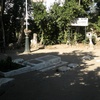Disclaimer
This entry contains information known to us from a variety of sources but may not include all the information currently available. Please be in touch if you notice any inadvertent mistakes in our presentation or have additional knowledge or sources to share. Thank you.
Archive
Tomb of Rabbi Ephraim Ainqaoua (Al Naqawa, Alnaqua, Encaoua), Tlemcen, Algeria
The tomb of Rabbi Efraim Ainqaoua (אפרים בן ישראל אלנאקוה, Al-Nakawa", "Al-Nakava", "Ankava", "Ankoa", "Alnucawi, Al-Naqawa, Alnaqaua, Encaoua), in Tlemcen (تلمسان / Tlemsan / ⵜⵍⴻⵎⵙⴰⵏ), Algeria.
In the 19th and 20th centuries, more than 10,000 pilgrims would converge on the Algerian city of Tlemcen every spring, nearly doubling its population.1 The Jewish cemetery on the then-outskirts of the city was the focus of their pilgrimage, in particular the tomb of Rabbi Ephraim Ain Kaoua and his family. The rabbi, who died in 1442, was renowned for miracle-working and is considered to have founded the Jewish community in Tlemcen.
Description
Rabbi Aln Kaoua: Born in Toledo in the 14th century, Ephraim Aln Kaoua fled Spanish persecution and arrived in Marrakesh, in present-day Morocco, in 1391. According to legend, he came to Tlemcen riding a lion, with an enormous serpent acting as the lion’s halter. Impressed by the sight of a man riding a lion, Sultan Abu Tashfin allowed Aln Kaoua to enter the city, where Jews had hitherto been forbidden from residing.2 Aln Kaoua miraculously cured the Sultan’s daughter’s illness, and as a reward the Sultan allowed him to bring more than five hundred families from the Balearic Islands to the city, establishing Tlemcen’s Jewish community. (However, some 21st century scholars claim that there was an existing Jewish population in Tlemcen, and that the rabbi simply made it more illustrious).3 The rabbi of Tlemcen in the 1880s wrote that miracles still occurred at Aln Kaoua’s tomb, more than four hundred years after his death.
The Jews of Tlemcen once made a grand pilgrimage to the Rab’s tomb during the Lag Ba’Omer holiday. This “hiloula” typically involved family picnics near the grave, musicians performing, and local officials paying their respects. Pilgrims would stop by the Rab’s spring to drink water – either pure or mixed with wine, anisette, or absinthe. People would also light candles, embrace the Rab’s tombstone, and retreat from the gravesite without turning one’s back on it.
1955 marked the last year of the full communal celebration of the Rab’s holiday. As Algeria grew more tense in the following years the festival was invariably canceled. And today the Rab has few visitors as he lies surrounded by the graves of his relatives and students, largely undisturbed.
The Tomb: A pilgrim in 1930 described “a route, bordered by thickly wooded trees screening the sunlight, conducts the pilgrim to the holy tomb. A simple iron portal guards the entrance. Then, one is taken on a long lane framed by reeds, young vines and clematis. At the end, in a circular clearing, one discovers a large rock whitewashed with lime. There, the remains of the great Rabb reposes [sic] over four centuries”.4 The inscription on Aln Kaoua’s tomb reads: “Here is the tomb of he who was our pride, our strength, the light of Israel, our teacher, versed in divine knowledge, renowned in his century, worker of miracles, the master of this place, the great rabbi Ephraim Aln Kaoua”.5
Sources
[1] Slyomovics, Susan. “Geographies of Jewish Tlemcen,” The Journal of North African Studies 5 (2000): 81-96. Accessed June 12, 2014. doi: 10.1080/13629380008718413
[2] Ibid.
[3] Ibid.
[4] Ibid.
[5] Weil, Moïse. Le Cimetière Israélite de Tlemcen. Avignon: Seguin Frères, 1881. Accessed June 12, 2014. http://books.google.com/books?id=m4MIAAAAQAAJ Jewish Virtual Library. “Tlemcen.” Last modified 2008. http://www.jewishvirtuallibrary.org/jsource/judaica/ejud_0002_0019_0_19884.html

![Tomb of Rabbi Ephraïm Aln Kaoua, Graves [2] (Tlemcen, Algeria, 2012)](https://cdn.filestackcontent.com/OUgx9wR5TnaVjT4ELRlp/convert?w=100&h=100&fit=crop)
![Tomb of Rabbi Ephraïm Aln Kaoua, Graves [1] (Tlemcen, Algeria, 2012)](https://cdn.filestackcontent.com/8udIL1yhRkJ6viPyFT6b/convert?w=100&h=100&fit=crop)
![Tomb of Rabbi Ephraïm Aln Kaoua, Old Photo of Graves [1] (Tlemcen, Algeria, n.d.)](https://cdn.filestackcontent.com/ZYse3g0GS0yF1ctu8zxR/convert?w=100&h=100&fit=crop)
![Tomb of Rabbi Ephraïm Aln Kaoua, Graves [3] (Tlemcen, Algeria, 2012)](https://cdn.filestackcontent.com/MAOfUTVQB6PmHUpr1Esg/convert?w=100&h=100&fit=crop)
![Tomb of Rabbi Ephraïm Aln Kaoua, Graves [4] (Tlemcen, Algeria, 2012)](https://cdn.filestackcontent.com/O1LJsO0RTguV4NTR1ZlY/convert?w=100&h=100&fit=crop)
![Tomb of Rabbi Ephraïm Aln Kaoua, Graves [5] (Tlemcen, Algeria, 2012)](https://cdn.filestackcontent.com/o7Pkty4FTNuU13sJlYmh/convert?w=100&h=100&fit=crop)


![Tomb of Rabbi Ephraïm Aln Kaoua, Graves [6] (Tlemcen, Algeria, 2012)](https://cdn.filestackcontent.com/UZvmY8dQ9KvPwYdRM6FA/convert?w=100&h=100&fit=crop)

![Tomb of Rabbi Ephraïm Aln Kaoua, Spring [4] (Tlemcen, Algeria, 2012)](https://cdn.filestackcontent.com/zrjsTZBQQSO2fTuUPKQb/convert?w=100&h=100&fit=crop)
![Tomb of Rabbi Ephraïm Aln Kaoua, Spring [3] (Tlemcen, Algeria, 2012)](https://cdn.filestackcontent.com/qZQi6KRrSs6UZWzdOxBx/convert?w=100&h=100&fit=crop)
![Tomb of Rabbi Ephraïm Aln Kaoua, Spring [2] (Tlemcen, Algeria, 2012)](https://cdn.filestackcontent.com/Ltg5CLtQL6717gFGoXEw/convert?w=100&h=100&fit=crop)
![Tomb of Rabbi Ephraïm Aln Kaoua, Spring [1] (Tlemcen, Algeria, 2012)](https://cdn.filestackcontent.com/3c2l5xxARjuVzdnDU2MS/convert?w=100&h=100&fit=crop)


![Tomb of Rabbi Ephraïm Aln Kaoua, Old Photo of Graves [2] (Tlemcen, Algeria, n.d.)](https://cdn.filestackcontent.com/88LK7m9mS5WKuAy5E7r2/convert?w=100&h=100&fit=crop)
![Tomb of Rabbi Ephraïm Aln Kaoua, Grave Detail [2] (Tlemcen, Algeria, 2012)](https://cdn.filestackcontent.com/8KKAS5XbRgqq128H3YcD/convert?w=100&h=100&fit=crop)
![Tomb of Rabbi Ephraïm Aln Kaoua, Grave Detail [1] (Tlemcen, Algeria, 2012)](https://cdn.filestackcontent.com/Brey4JD6TVCADNSAB4Tp/convert?w=100&h=100&fit=crop)
![Tomb of Rabbi Ephraïm Aln Kaoua, Grave [2] (Tlemcen, Algeria, 2012)](https://cdn.filestackcontent.com/XbbyvZdoSU67YzeT4TyS/convert?w=100&h=100&fit=crop)

![Tomb of Rabbi Ephraïm Aln Kaoua, Grave [1] (Tlemcen, Algeria, 2012)](https://cdn.filestackcontent.com/4F7MbUiNRNmTgAZbXkEu/convert?w=100&h=100&fit=crop)

![Tomb of Rabbi Ephraïm Aln Kaoua, Interior Sign [2] (Tlemcen, Algeria, 2012)](https://cdn.filestackcontent.com/EEJL4oITxGUtkmh8cqRV/convert?w=100&h=100&fit=crop)
![Tomb of Rabbi Ephraïm Aln Kaoua, Interior Sign [1] (Tlemcen, Algeria, 2012)](https://cdn.filestackcontent.com/hEL7O58QPec9YOi1hDKA/convert?w=100&h=100&fit=crop)

![Tomb of Rabbi Ephraïm Aln Kaoua, Path [2] (Tlemcen, Algeria, 2012)](https://cdn.filestackcontent.com/ztTeFrIlQTq1ux86UW57/convert?w=100&h=100&fit=crop)
![Tomb of Rabbi Ephraïm Aln Kaoua, Path [1] (Tlemcen, Algeria, 2012)](https://cdn.filestackcontent.com/Y4zo1e8MRrGIJFTUqjaD/convert?w=100&h=100&fit=crop)



![Tomb of Rabbi Ephraïm Aln Kaoua, Exterior Sign [1] (Tlemcen, Algeria, 2012)](https://cdn.filestackcontent.com/ybvpkJ36Tn6OSaaVt2ly/convert?w=100&h=100&fit=crop)
![Tomb of Rabbi Ephraïm Aln Kaoua, Exterior Sign [2] (Tlemcen, Algeria, 2012)](https://cdn.filestackcontent.com/Wk2UNs1Qu6k0mqkhXFq6/convert?w=100&h=100&fit=crop)